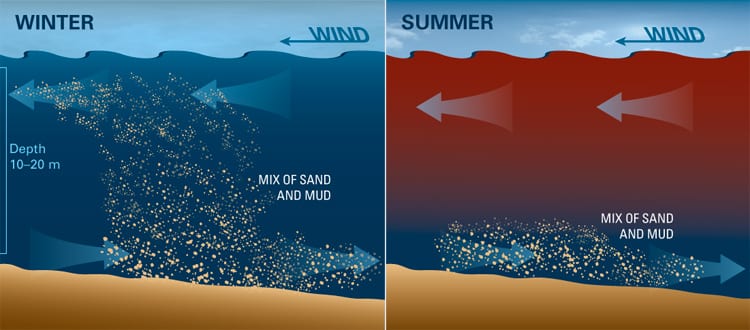The Gateway between the Beach and the Deep Sea
Anything traveling from the shoreline to the ocean and vice versa—water, fish larvae, sand, pollutants—must go through the shallow inner shelf, which connects the beach to the deep ocean. There’s a whole lot of physics going on there. Take sand, for instance. As waves and tides moveback and forth, they can stir up sand and sediments in the shallow inner shelf region. That can lift particles into the water, where they can be transported horizontally by currents. How far and in which direction the sand will travel depends on several factors, including how high they are lifted, which can change with the season.
Warm water is less dense than cold water and fresher water is less dense than saltier water. In winter, frigid air cools water on the surface, making it denser. It sinks, mixing all the water below it on the way down. Winter storm winds also do lots of mixing so all of the water is the same temperature from top to bottom. With the ocean comprised of one big, thick, cold layer, sand and mud can mix throughout the whole water depth, all the way to the surface, and can potentially be carried a longer distance horizontally.
In summer, warm air and sunshine heat up the surface water, creating a layer of warmer, less dense water that stays above colder, denser water below. This layering makes it harder for water from the surface and bottom to mix; sand and mud can be trapped in the lower layer of water. Recent research has shown that this capping effect has significant implications and should not be overlooked when scientists try to predict the movement of materials through the inner shelf regions.
(Illustration by Amy Caracappa-Qubeck, Woods Hole Oceanographic Institution)
Image and Visual Licensing
WHOI copyright digital assets (stills and video) contained on this website can be licensed for non-commercial use upon request and approval. Please contact WHOI Digital Assets at images@whoi.edu or (508) 289-2647.

